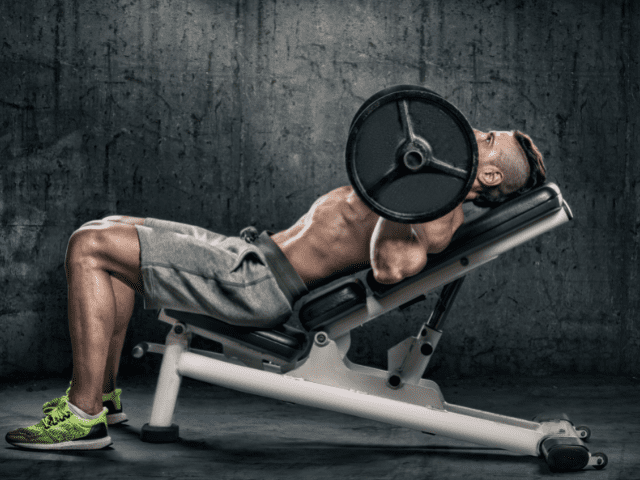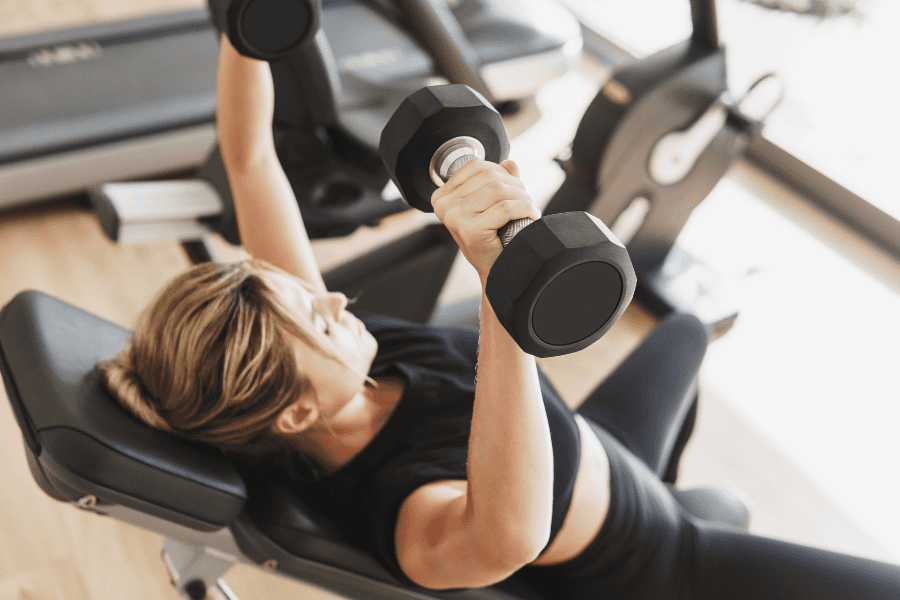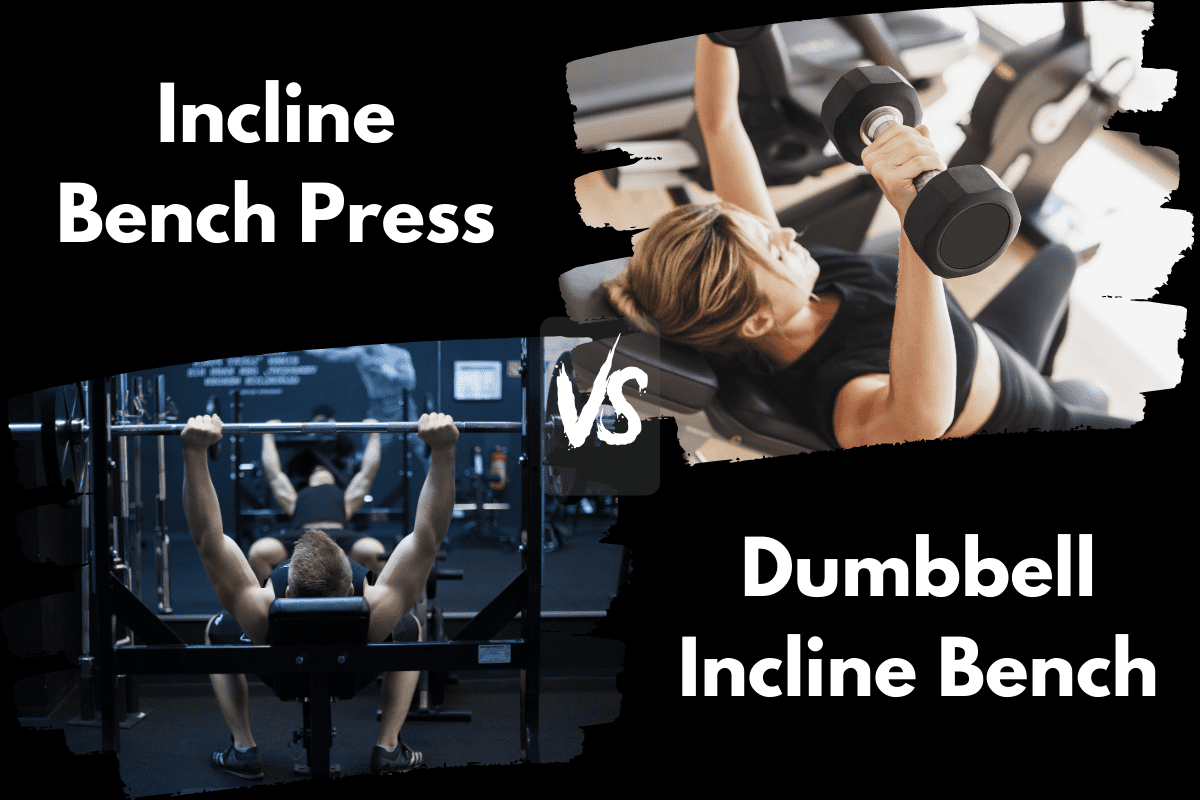Incline Bench Press vs Dumbbell Incline Bench: Is One Better?
Incline Bench Press and Dumbbell Incline Bench are easily two of the most popular Bench Press variations you’ll see being done in almost any weight room.
Obviously, both exercises are pressing movements that target the chest, shoulders and triceps. One is done with a barbell and the other with dumbbells. But, is one better than the other?
In this article, I’m going to break down how to do both Bench Press variations along with the benefits of each exercise. Then, I’ll compare the two exercises side-by-side for a few common lifting goals so, hopefully, you can get an idea of which you should include in your workouts.
Incline Bench Press

Equipment Needed
- Multi-purpose lifting rack
- Bench
- Barbell
- Bumper or Iron plates
Step-by-Step Instructions
- Determine the angle for your incline bench. Most programs would refer to a 45-degree angle as ideal for it provides the best chest and shoulder engagement.
- As you go higher with your angle, you are moving more toward a shoulder press. The flatter the bench gets, you are moving more toward a regular bench press.
- Set the height of the barbell so that when you unrack the barbell, you are only doing a very short upward concentric movement.
- Lie flat on your back on the bench.
- Keep your feet flat on the floor.
- Pull your shoulder blades together and keep the back of your head on the bench. You will slightly arch your back. Keep your core tight and keep the shoulder blades pulled back tight.
- Take a thumbs-width grip from the knurling and completely close your grip. Keep your knuckles pointing toward the ceiling and squeeze the barbell.
- Unrack the weight and take a deep breath.
- Control the barbell down during the eccentric movement and draw the barbell in, keeping the elbows at about a 45-degree angle away from the torso.
- The barbell will make contact with your torso right at the nipple line on the chest.
- Once contact is made, drive the barbell back up to the starting position.
Coaching Points
Make your angle appropriate for your goals and injury history. I do not typically recommend an incline bench angle greater than 45 degrees.
If a lifter wants to do a shoulder press, I would recommend standing and pressing.
The Incline Bench Press is a great movement for lifters looking to gain strength in their shoulders and chest. Using the same implement will also carry over to specific strength for the bench press.
Dumbbell Incline Bench Press

Equipment Needed
- Dumbbells
- Adjustable Bench (Capable of changing angles)
Step-by-Step Instruction
- Determine the angle for your incline bench. Most programs would refer to a 45-degree angle as ideal for it provides the best chest and shoulder engagement.
- As you go higher with your angle, you are moving more toward a shoulder press. The flatter the bench gets, you are moving more toward a regular bench press.
- Grab your dumbbells, sit on the edge of the bench, and sit the dumbbells on your thighs vertically.
- Take a deep breath, lie flat on your back on the bench, and get your dumbbells in position ready to press.
- Keep your feet flat on the floor.
- Keep your butt on the bench.
- Pull your shoulder blades together and keep the back of your head on the bench. You will slightly arch your back. Keep your core tight and keep the shoulder blades pulled back tight.
- The dumbbells should be slightly angled (representative of the path you are descending with your elbows).
- Press the dumbbells up.
- Control the dumbbells down during the eccentric movement and draw the dumbbells in, keeping the elbows at about a 45-degree angle away from the torso.
- The dumbbells will make contact with your torso right at the nipple line on the chest.
- Once contact is made, drive the dumbbells back up.
- When your set is done, do not freely drop the dumbbells without checking your surroundings. You could drop the dumbbell and it might hit a person nearby. Or your could drop your dumbbell and crush your fingers on a dumbbell that was left next to your bench.
- The best way to finish a set is to bring the dumbbells back to your thighs and stand up with them. Or have a lifting partner take them from you.
RELATED –> 10 Best Dumbbell Incline Bench Press alternatives
Coaching Points
Remember as you move your bench up, the more you are engaging the shoulders and less chest. Be sure your angle matches the goals you’ve set for pressing.
This is a very shoulder-friendly pressing movement. Because the implement is a dumbbell, the range of motion is increased, the shear force on the shoulder is decreased, and the shoulder stabilizing muscles are engaged.
I would highly recommend Dumbbell Incline Bench Press to any athlete. It provides all the benefits that a pressing movement can offer with minimal risk.
Dumbbell Incline Bench Press vs Incline Bench Press – Which is Better?
Now, let’s do a side-by-side comparison of the two bench variations for a couple of common lifting goals.
Better For Building Strength and Size: Barbell Incline
I’m going to say Incline Barbell Bench, but because of logistics only, not because of the two movements themselves. Here’s what I mean:
Once you start to develop a good amount of strength, you’re most likely going to be limited by the availability of heavier and heavier dumbbells. Even at commercial gyms, you’re probably lucky if you have access to any dumbbells over 100 pounds. If you’re lifting at home that number will most likely be much less.
On the other hand, even if you’re lifting at home, it’s not hard to have as much weight as you want for Incline Bench Press with a barbell and weight plates.
As for hypertrophy, there are some studies that show that dumbbells elicit more muscle activation than a barbell. On the other hand, generally speaking, more overall weight can be used with a barbell than with dumbbells which can lead to better gains in muscle mass.
Dumbbells also allow for a slightly better range of motion and will also help reduce any muscle imbalances that may develop over the course of training.
The bottom line is, one movement is not a clear favorite over the other when it comes to muscle growth. Unless, as I mentioned with developing, you’re limited in the size of dumbbells you have access to. Then, the advantage is going to be with Barbell Incline.
Better on the Shoulders: Dumbbell Incline
I would give the nod to Dumbbell Incline Bench Press as being better on your shoulders. Using dumbbells allows the lifter more variance on the movement path than a barbell. This gives the lifter more freedom to find a movement pattern that will be less stressful on the shoulders than a barbell.
The stabilizer muscles of the shoulder are also going to be much more active when using dumbbells. This provides benefits to the overall health of the shoulder, especially for athletes.
Better For Beginners: Dumbbell Incline
I would give the nod to Dumbbell Incline Bench as being better for beginners too.
One of the reasons is that the barbell has an entry point of 45 pounds. For some beginners, that may be a little more than they’re ready for when they first get started. Dumbbells make it much easier to start with lighter weights.
The other reason is that dumbbells elicit more of a neuromuscular demand than a barbell. This will help beginners learn how to stabilize movements and control weight through full ranges of motion quicker.
Final Thoughts
I’ve just spent an entire article comparing Dumbbell Incline Bench Press vs Barbell Incline Bench Press. However, the truth is, there is no reason you shouldn’t have both exercises in your strength training program.
Both are excellent exercises for building strength and hypertrophy. And, both exercises actually complement each other well. Finally, incorporating both into your training can also add much-needed variety to keep your workouts from getting stale.
So, my suggestion would be instead of trying to decide between the two exercises, figure out how you can utilize both Dumbbell Incline Bench Press and Incline Bench Press in your training plan.
If you liked this comparison you may also want to check out my 9 favorite alternatives for Incline Bench Press.

